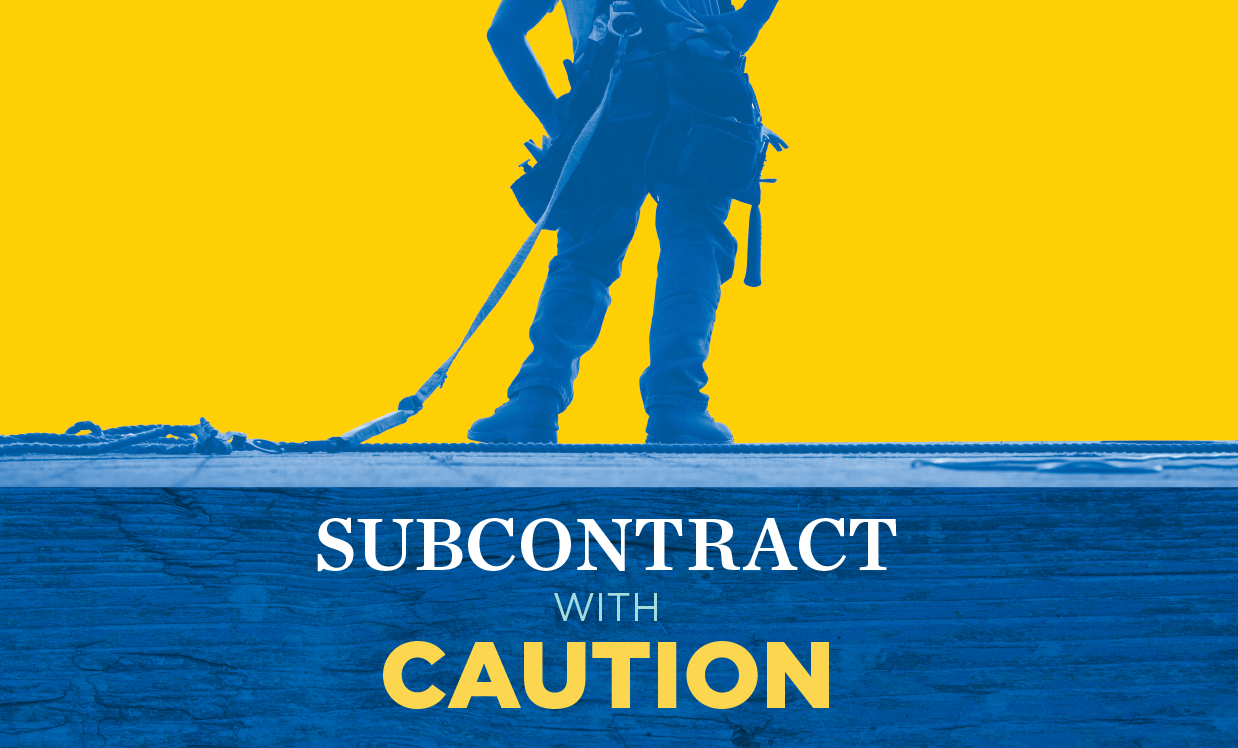Editor’s note: This article is for general educational purposes only and does not constitute legal advice.

|
For the past several years, a lack of skilled labor has been one of the most significant challenges the construction industry has faced. The issue has been exacerbated during the COVID-19 pandemic as more employees leave employment for a myriad of reasons, including safety concerns, working conditions, and mask and vaccine mandates.
One option for combating the labor shortage is using subcontractors. However, before you go this route, be sure you understand all the requirements, as well as the potential pitfalls.
Proper classification
Employee misclassification is a hot topic, and the Biden administration has made enforcing proper classification a priority. Essentially, if you classify a worker as an independent contractor, you are not required to pay his or her benefits, unemployment insurance, payroll taxes and other full-time employee necessities. However, you must be able to prove the subcontractor is not acting as an employee. A government agency inspecting the classification status of a subcontractor is looking at the subcontractor’s degree of independence. Does he or she work for others; have a website; wear his or her own safety gear; and operate as a business? Or is he or she simply a misclassified employee of the prime contractor?
Checking references
When you begin the process of hiring subcontractors, take time to get referrals and talk to other contractors about their work. Make sure any subcontractor you hire is properly licensed and insured and carries workers’ compensation insurance. Meet with the subcontractors you are considering and talk to them about your goals and priorities. You want to be certain they share your ambition. Also, request to see their safety records, and remember their work will reflect on your company.
Careful oversight
If you choose to use subcontractors, know that for the arrangement to be successful, you will need to ensure quality control and production. If you know the subcontractors well, you may trust them easily and feel confident they will deliver good work. However, if you are hiring them for the first time, you may need to be on the job site regularly to check their output.
Multi-employer worksites
Keep in mind for projects involving multiple employers, the Occupational Safety and Health Administration could determine one employer is responsible for the actions of others. So depending on the employment relationship, OSHA could hold you responsible for your subcontractors’ safety violations. On a multi-employer worksite, OSHA categorizes employers based on their involvement in hazardous conditions or their supervisory authority.
DID YOU KNOW? NRCA offers the contract provisions mentioned in this article and many others as part of its legal resource center at nrca.net/legal.
Crucial contract provisions
To protect yourself when entering into agreements with subcontractors, be sure you review your contracts and include several key provisions such as:
- Anti-controlling contractor provision: This clause stipulates you are not a controlling contractor, meaning you are not expected to recognize and prevent all worksite safety issues. Instead, the subcontractor understands and acknowledges all required safety standards and is responsible for maintaining his or her safety on the job site.
- Reporting injury, illness or dangerous conditions provision: Per this provision, the subcontractor is required to complete all work in an expeditious and safe manner. He or she should follow OSHA regulations and comply with all laws, statutes, codes and rules for the safety of the project’s property and participants. In addition, the clause directs the subcontractor must report any injuries, accidents or illnesses that occur on-site that involve his or her workers. The subcontractor also must notify the prime contractor of any unsafe conditions.
- Indemnification provision: If the subcontractor or his or her employees fail to comply with any safety regulations or if their acts or omissions result in damage on a project, this provision stipulates the subcontractor will hold you harmless for any related liability, expenses and/or fees.
- Safety training and safety inspection responsibilities provision: This provision makes the subcontractor solely liable and responsible for establishing safety protocols, working prudently and safely, and training his or her employees. You have no obligation to train a subcontractor’s workers. If any injury or property damage results from the subcontractor’s actions or any violation or incident extends from his or her work, he or she will be named as the at-fault party.
- Independent contractor provision: If you have clearly proved the subcontractor is an independent contractor, be sure to include a related provision in your contract. This clause confirms the subcontractor is not your employee or partner. Further, it states the subcontractor is solely liable for all federal and state taxes related to performance, including workers’ compensation, unemployment insurance and Social Security payments.
- Liability provisions: Without the appropriate provisions governing construction defects in your contract, you can be held solely liable for any defects caused by a subcontractor. Be sure to include clauses stipulating the subcontractor is responsible for any construction defects resulting from subpar work and will correct those defects. The scope of this liability varies among states, so check your local laws.
For an article related to this topic, see “Weighing the risk,” March 2019 issue.
Final advice
Using subcontractors may be vital for your business, and when you work with respected, reliable subcontractors, you will see positive results. However, there are many details to keep in mind when you enter a subcontracting agreement. Double-check your subcontractors are insured and licensed, and make sure they understand your expectations. Also, review all the provisions mentioned here and consider adding them to your contracts. Their insertion will eliminate any confusion about who is responsible for safety protocols, violations, training, defects and other pertinent issues on a construction site.
TRENT COTNEY is CEO of Cotney Attorneys & Consultants, Tampa, Fla.



